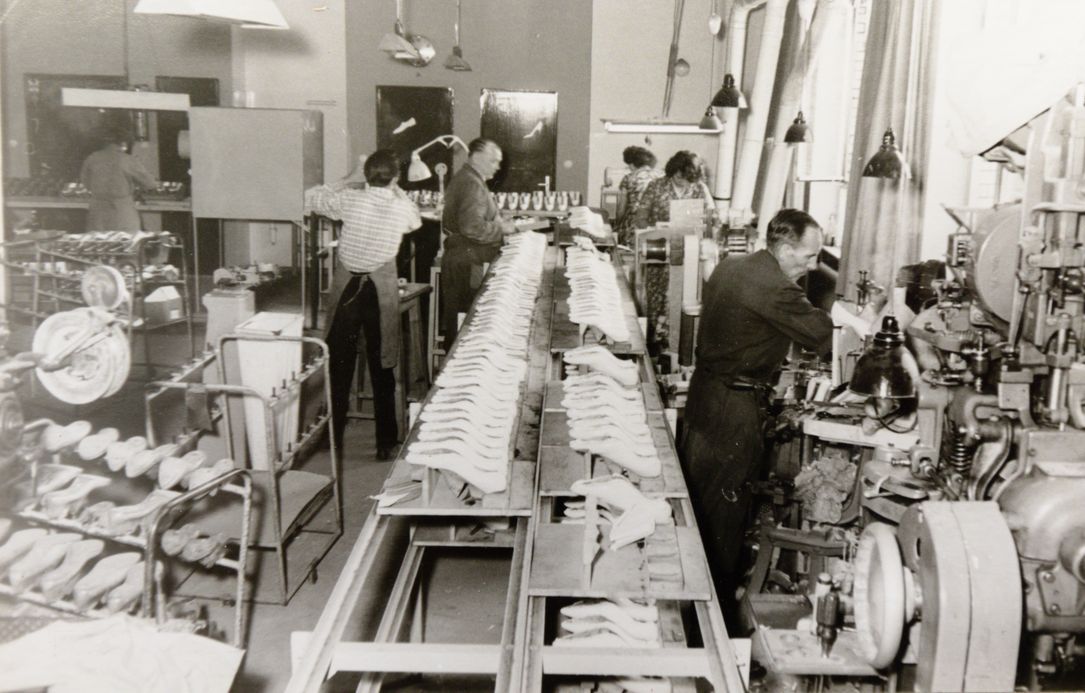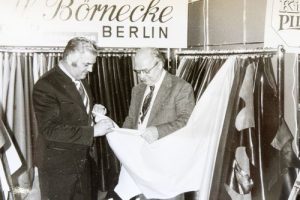From lasts to leather
The Berlin leather wholesaler J&W Börnecke was established 100 years ago. Raw materials for orthopaedics, and increasingly fashion, are the mainstays of this company.
The history of the leather wholesaler J&W Börnecke also reflects the industrial, craft and political developments in Germany. Founded at a time when many small manufacturing enterprises dominated the shoemaking business, saved from the desaster of the Second World War, led through the Berlin Blockade, the building of the Berlin Wall and the reunification of Germany, it today represents a company true to the spirit of its founders, as it remains firmly anchored in (orthopaedic) shoemaking. However, for many years, the family business has also represented a fixture for all of those who are looking for exceptional, specially styled or dyed leather for unique clothes in the fashion industry.
1919 was the year of birth of the leather wholesaler J&W Börnecke, which has been located in Berlin ever since. J stands for Julius, the younger brother who was born in 1886, W stands for Wilhelm, born 1885 and actually called Friedrich-Wilhelm.
The shop was opened in the spring of 1919 on Möckernstraße in Berlin Kreuzberg.

Leather was not always at the centre of J&W Börnecke. In the early days, the company was a business for shoe lasts. The trade with the material without which no shoemaker cannot get by was not accidental, but stems from our family history:
The father of the two, Dietrich Börnecke, was a trained shoemaker. He was born an illegitimate child in Witten an der Ruhr. His mother, a Börnecke by birth, came from Bochum. Who was Dietrich’s father? That is unknown. But he seems to have been a wealthy man, who rid himself of unwanted fatherhood by banishing his lover to Witten to give birth. It is there that Dietrich was born.
Following his training, Dietrich Börnecke appears to have married fast at age 18 and started his own business. He and his wife Lina gave birth to three daughters, Hedwig, Alma, and Lilly, and the two sons Wilhelm and Julius. Dietrich’s father from Bochum, who is today unknown to the family, is said to have paid him a form of compensation which enabled him to open a shoe retail business in Dortmund. When he died in 1934, the business was managed by his oldest daughter Hedwig (called the „duchess“).
However, Dietrich was also a manufacturer. He built shoe lasts. At a time, when no differentiation was made between left and right shoes, Dietrich Börnecke fashioned left and right lasts for the shoemaking craft.

Such lasts were in high demand, and he appeared to have been skilled in manufacturing them. He seems to have received a regular income from C. Behrens, a company for shoe lasts located near Hannover, for an invention (which may even have been patented). This profit must have been significantly high, since the shoemaker no longer worked ever since – or at least no longer at full steam. Instead, his daughters took over work at the shoe retail business.
In the times of war, when everything was scarce, Dietrich Börnecke had bizarre ideas: he constructed the so-called „iron shoe“, which he at least designed, but also may have built. His grandson Rudolf Börnecke remembers: „No one knows whether this invention ever amounted to more than a model. But everyone remembers it.“
His sons Julius and Wilhelm, in any case, were very familiar with the business of shoes, leather and lasts when they returned from the First World War. Julius, stationed in a guard’s regiment in Berlin, came to Potsdam into a military hospital and decided, not to return to provincial Dortmund. Together with his brother, who was one year his senior, the trained businessman, who sold shoes as a travelling merchant before the war, used the connections of his father to shoe last factories. In this case too, Behrens could have played a role as a supplier, as Rudolf suspects.
After the First World War, everything was scarce. So too were shoes and the lasts required for their production. From then on, Julius and Wilhelm supplied many of the small and smallest shoemaker businesses and factories in Berlin from their shoe retail business on Möckernstraße. There was a great demand for the central element of shoemaking. Not only lasts for common shoes and boots, but among other things also lasts for ball shoes, which were popular. For this reason, so-called „turnshoe makers“ were also supplied: they produced shoes without insoles, as the shoes were pulled from the last and sewn „inside-out“.
The business was successful, but the trade in lasts receded due to an increasing industrial production into the background – leather became a more and more central commodity of the business of J&W. The company moved, at first, probably in 1926, to the Große Frankfurter Straße, and later, around 1928, into the Alexanderpassage, a building complex with several courtyards near Alexanderplatz. There, the company was bombed in 1943. A photograph depicts the rubbel. Only a now historical safe was preserved from that time.
25 years after its founding, J&W Börnecke had become an important company, which supplied businesses in the surrounding areas, such as shoe factories in Brandenburg, Frankfurt/Oder, Straussberg or Ludwigsfelde. What was also testament to the importance of the business was that it was given an extensive delivery rights after having been forcibly moved to Doberlug-Kirchhain in Southern Brandenburg: J&W Börnecke was the preferred supplier of leather for officers’ boots across all regions to Königsberg. Shoemakers who produced such shoes had to order the raw materials from J&W with ration coupons.

Already in 1954, the company gained an invaluable member of staff, who is part of the business up until today: Dieter Schefter had just completed his training as a wholesale trader at other companies and started working at J&W. His advantage: Schefter brought along well-founded knowledge on upper leather – up until today.
In the 60s and early 70s, the most important customers were the at the time still numerous shoe factories in Berlin, as well as the manufacturers of leather clothing, belts, and gloves. The isolated location of the city rendered it increasingly difficult for these industries to work successfully. Additionally, after the building of the Berlin Wall, there was a significant lack of labour forces, as well as an overwhelming amount of imports of cheaply produced shoes and clothing, first from Italy, later also from other southern European and finally Asian countries.
Solely orthopaedic shoemakers did not encounter these issues. J&W therefore decided to greatly expand this field. This proved to be a beneficial strategy that has been successful up to this day, and soon led to the expansion of the business into West Germany. Meanwhile, Günter Börnecke, the son of the company’s founder Julius, changed from the shoe factory Rudolf Börnecke OHG to J&W in 1966, where he later took over business management. In 1970, Dieter Schefter first drove with a car full of leather across the GDR to lower saxony. There, the company gradually gained a new regular clientele in the field of orthopaedic shoemaking. The decision had not been an easy one, since the numerous journeys on the crumbling motorways of the GDR were accompanied by ludicrous controls at the border crossings.


The sales success which soon developed served as an encouragement to later expand the trade across the whole of FRG and, after the reunification, across the whole of Germany. This is why, since the 70s, J&W is present at all orthopaedic fairs and events.
Since then, more family members of the generation of later founders became fixtures in the company, such as Frank Börnecke, who joined in 1986, and Angelika Börnecke, who was taken into the company by her father Günter in 1980. Since 2001, she holds the management position and expanded the trade of the company to the international market. By now, the company supplies to many EU countries, and at the latest since Saskia, Julius’s great-granddaughter, joined the company, the regular clientele has been expanded to young people in the fashion industry. Instagram and Twitter are today as much means to sell and advertise as the company’s new presence online. However, without any of the oldies, it would not work even today: Dieter Schefter, who has been part of the company for 65 years this year, still provides advice to J&W one day a week.
